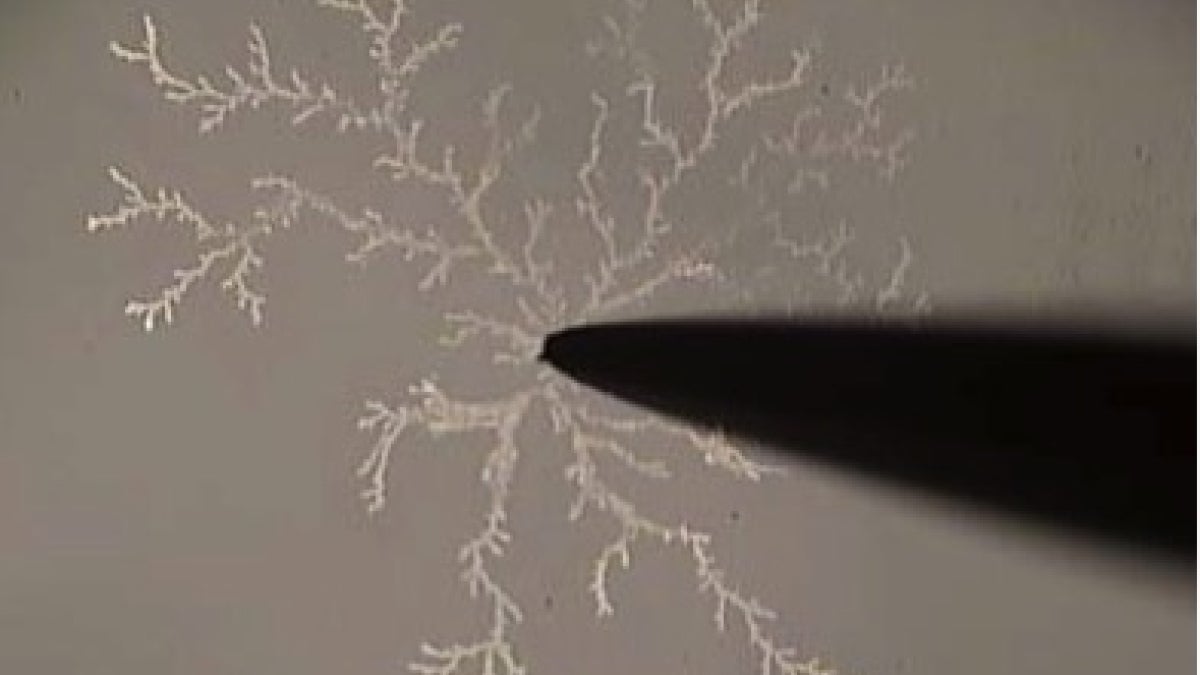ASU proves its patent prowess with global ranking

A dendritic electrode is shown growing on the surface of a silicon wafer. Michael Kozicki found that the easily grown, lacy dendritic metal electrodes can be used in photovoltaics such as solar panels, where normal electrodes end up blocking part of the light they’re supposed to gather. (The black area in the image is a probe needle, used to form the dendrite and also to connect to it in the lab for testing.)
Photo by: Minghan Ren
Michael Kozicki is no stranger to patents.
The Arizona State University professor – who has 50 here in the U.S. and about 30 foreign equivalents – has had so many significant patents that he was inducted into the National Academy of Inventors in March.
That was no easy feat, he said.
“You have to be an evil genius, basically,” said Kozicki, who is with the School of Electrical, Computer and Energy Engineering in the Ira A. Fulton Schools of Engineering. “You have to have invented a battery or stolen a planet.”
Though neither evil nor kleptomaniacal, ASU is no stranger to patents, either.
A new report from the National Academy of Inventors and the Intellectual Property Owners Association ranks ASU among the top 50 international universities for the number of patents issued to its researchers in 2014. ASU’s 48 patents granted that year tied it for 44th, just ahead of Duke University.
One of the patents awarded that year went to Kozicki’s dendritic metal electrodes. He had been studying the growth of dendrites, which are constantly branching patterns that grow easily.
“They look really like trees,” he said. “We realized that they have some utility as electrodes because they could be grown on a substrate, on a device. They are fine enough that they can let light through but can still gather electrical impulse.”
That means they can be used in photovoltaics like solar panels, where normal electrodes end up blocking part of the light they’re supposed to gather. Kozicki’s dendrites are transparent enough that they gather the solar impulse without blocking any of it.
He wasn’t surprised at ASU’s making the patent list.
“ASU continually does really well in these kinds of polls…,” Kozicki said. “To get where we are on these lists is actually pretty spectacular.”
The ranking reflects the ASU’s dedication to use-inspired research and building innovative technologies that contribute to our communities.
“The granting of 48 utility patents continues to demonstrate that our faculty and students are on the frontiers of science and at the forefront of developing new and meaningful technologies that extend to Arizona and beyond,” said Sethuraman Panchanathan, senior vice president of Knowledge Enterprise Development at ASU.
“As a rapidly growing research enterprise, these patents recognize the uniqueness of the work performed at ASU and the direct societal impact it has on the nation at large.”
Making a difference in the world is part of what drove Jeffrey La Belle to create a diabetic-monitoring device. The traditional way to monitor blood glucose involves finger pricks up to eight times a day, a painful requirement that makes it difficult for diabetics to comply. La Belle’s device uses tear fluid instead.
“A student and I were trying to come up with a tear glucose sensor that was simple and practical back in 2009,” said Jeffrey La Belle, an assistant professor in the School of Biological Health and Systems Engineering; the Harrington Biomedical Engineering Program; and the Biodesign Institute.
They created a disposable device that promises to greatly reduce pain. It was awarded a patent in 2014 – a five-year stretch that is a fairly typical timeframe for patents. It takes much more time and money to achieve than a publication.
“In a patent, there are many steps and stages, dealing with the IP (Intellectual Property) office, lawyers, the U.S. Patent and Trademark Office, lots more to it than most people would realize,” La Belle said.
Stephen Albert Johnston said it took three meetings with patent examiners for his immunosignatures to get through the patent process.
The co-director of the Center for Innovations in Medicine at the Biodesign Institute and professor in the School of Life Sciences wanted to invent something that would allow people to monitor their health on a regular basis and detect diseases early.
After many unsuccessful attempts, he finally came up with the idea of immunosignatures, in which a drop of blood or saliva is diluted and applied to a special chip. The chip is washed, and the only thing that sticks to it is antibodies, which give a reading of a person’s health status.
Those antibodies can change, and Johnston’s team is in the process of defining the antibody parameters for a number of diseases. They’ve looked at 45 so far.
He and Neal Woodbury, an ASU professor of biochemistry and chemistry and co-director of the Center for Innovations in Medicine, have spun immunosignatures into a company, HealthTell, which is focused on detecting cancer early and which is in a second round of fundraising.
But their research portfolio here at ASU is largely driven the interests of those who submit blood samples to be tested. And it doesn’t have to involve humans.
“Maybe a quarter of the people use it for dogs,” Johnston said. “(But) we’ve never done cats.”
The patent-ranking report is based on data obtained from the U.S. Patent and Trademark Office. The National Academy of Inventors and the Intellectual Property Owners Association compile the rankings each year by calculating the number of utility patents granted by the U.S. Patent and Trademark Office which list a university as the first assignee on the printed patent. Find the complete list here.

